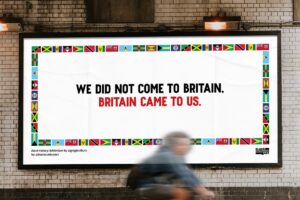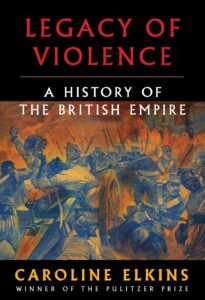|
Getting your Trinity Audio player ready...
|
Reading Time 4 mins
November 3, 2022
“…. she was the symbol of an empire built on genocide, slavery, violence, extraction, and brutality, the legacies of which continue in our present day.” Arabindan-Kesson, professor, Princeton University
 The Queen is dead. Is the long living façade of a kind and gentle monarchy also dead? Probably.
The Queen is dead. Is the long living façade of a kind and gentle monarchy also dead? Probably.
Will the “sins” of the mother be visited upon her eldest child, King Charles III? Probably.
Queen Elizabeth II reigned from February 1952 until her death in September 2022 for 70 years and 214 days—the longest of any British monarch. Fifteen British prime ministers served under her, and fourteen United States presidents called her their staunchest ally. She walked on to the world stage with historical leaders, including Winston Churchill, Prime Minister of Britain; Joseph Stalin, Premier of the Soviet Union; Harry Truman, President of the United States; Mao Zedong, President of the People’s Republic of China; Chiang Kai-Shek, President of the Republic of China; Francisco Franco, Head of the Spanish State; Fulgencio Batista, President of Cuba; and Hector Trujillo, President of the Dominican Republic.
Twenty-five-year-old Princess Elizabeth was vacationing in the British colony of Kenya with her husband, Prince Philip, when she was startled to learn that her father, King George VI, had died in his sleep—making her the Queen.
However, Queen Elizabeth II was not the only one in pain and separated from home at that moment. Almost 1.5 million Kenyans were in detention camps and segregated villages operated by the British government. Rape, castration, and imprisonment were employed to squash the quest by the Kenyan people and the Kenya Land and Freedom Army (known as the Mau-Mau) to fight for their independence from Britain. This day-one tableau would be a harbinger of the stark contrast between the world of the monarchy and the real world. So what did Princess/Queen know—about Kenya, what occurred outside her palace walls, or being Queen?
“How Britain Underdeveloped the Caribbean: A Reparation Response to Europe’s Legacy of Plunder and Poverty,” by Hilary McD. Beckles describes three hundred years of colonial rule of the British West Indies, whereby Britain extracted wealth created from enslaved African labor to benefit the monarchy. Seventy years of these three centuries belonged to the late Queen.
of Plunder and Poverty,” by Hilary McD. Beckles describes three hundred years of colonial rule of the British West Indies, whereby Britain extracted wealth created from enslaved African labor to benefit the monarchy. Seventy years of these three centuries belonged to the late Queen.
A documentary entitled “The Royal Tour of the Caribbean” recorded Queen Elizabeth’s and Prince Philip’s tour of the British West Indies in 1966. Produced by the British Colonial Office, the royals visited examples of successful projects on various Caribbean islands: Queen Elizabeth Hospital, the East Coast Road in Barbados, and a deep-water harbor in St. Vincent. Although highly curated, Queen Elizabeth’s tour certainly passed by cane cutters, under-developed land, and poor housing. In addition, she must have seen damning examples of the stagnant growth and racial disparities not entirely hidden in the newly liberated nations and the long-time British colonies.
During her reign, did the Queen keep The Queen’s Coronation Oath, 1953, when she promised and swore a) to govern her possessions according to their respective laws and customs and 2) to enact a law, justice, and mercy when making decisions?
Did she serve “as a focus for national identity, unity, and pride; give a sense of stability and continuity; officially recognize success and excellence, and support the ideal of voluntary service”?
Was she a successful monarch?
“An interesting aspect of white supremacy and dominion is that we are basically, on all levels, taught to celebrate our oppressors…. we are taught to give them a pass and see them as great people who were reflective of the times in which they lived.” – Morgan “Malam” Peters, a member of the Mashpee Wampanoag Tribe
At the beginning of her reign, the British Empire comprised seventy territories. When the Queen died, that number had been reduced to fifteen. However, she did organize many of her former colonies into the British Commonwealth of Nations. Although 55 countries gained independence during her reign, many were ushered out as they increasingly became economic albatrosses for the financially strapped post-World War II British. Better to separate from them than to attempt to develop economies that had been intentionally devastated by British colonialism. Depleted colonies were not worth the fight, so Britain magnanimously “freed” them, citing the 1941 Atlantic Charter of Allied War Aims that recognized “the rights of all people to choose the form of government under which they will live.” Several Caribbean leaders took the initiative, chose their form of government, and initiated revolutionary steps to achieve their goal of nation-building.
The British government governed 200 million fewer people from 1945 to 1965 as the Empire continued to waver. Twelve former colonies of Britain gained their independence between 1962 and 1983. However, since English is spoken by 1.5 billion people globally and many countries have adopted the English Parliamentary system for governance, British influence is ubiquitous. Queen Elizabeth did well financially: her wealth exceeded $500 million, and Royal Family assets are valued at $28 billion. So how do these figures influence her legacy?
King Charles III will bear the entire blame for everything people disliked about the monarchy but grudgingly accepted because it was Queen Elizabeth. Questions about the relevance or need for the monarchy will be advanced more loudly and aggressively. Already, additional Caribbean countries are taking steps and following the lead of Barbados and cutting ties with Britain. Reparations discussions will be front and center globally.
Does King Charles III have the requisite demeanor and leadership qualities to steer his country and family through the uncharted waters surrounding his island country? Will he be under constant, vicious pressure from the media to act or not? Are the white kid gloves off, and everyone from everywhere will be coming for him—in a manner typically reserved for non-royals? Will King Charles III wilt and stay hidden or channel his despotic ancestors and do what he bloody well pleases?
The Queen is dead. Long live the King!
Uju Anya, an associate professor of second language acquisition at Carnegie Mellon University, reminds us,
“There are people… around the world, rejoicing at this woman’s death, not because they’re vile or cold but because her reign and the reign of her monarchy by extension was violent.”
Big Drum Nation introduction to the “London Bridge is Falling Down” series
 Carlyle G. Leach is an educator and author of the memoir, Six Days in December: My Father’s Journey Home. He is passionate about family, social justice, playing trumpet and flugelhorn, coaching baseball, New York sports teams, the mystical, and reading. Carlyle lives in Manhattan with his wife and has two adult sons who visit frequently. Follow him on Twitter @CarlyleLeach.
Carlyle G. Leach is an educator and author of the memoir, Six Days in December: My Father’s Journey Home. He is passionate about family, social justice, playing trumpet and flugelhorn, coaching baseball, New York sports teams, the mystical, and reading. Carlyle lives in Manhattan with his wife and has two adult sons who visit frequently. Follow him on Twitter @CarlyleLeach.

Hope we can learn from the past, so we don’t repeat into the future
People forget and remain mired in past thought patterns.